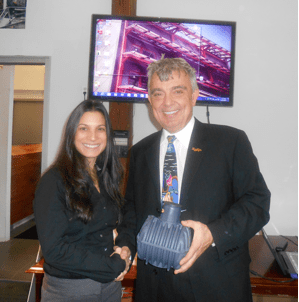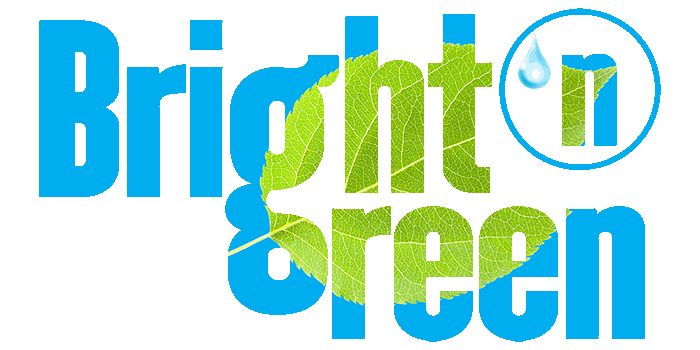On Thursday December 5th, in conjunction with the Living Building Institute and the Brooklyn Chapter of the AIA, Bright ‘n Green hosted a talk on two of the most important petals of the Living Building challenge: water and materials at the Scarano 110 York Street office.
After the talk and buffet lunch attendees traveled to the site of Bright’n Green – the first ever Living Building Challenge Net Zero Energy multi-family mixed-use building – for a two hour guided tour of the project, its systems and how it is one of the most important projects to be built in the last 100 years in NYC.

Developer and Architect Robert Scarano, Jr., AIA, FARA, ALA, is congratulated by AIA Brooklyn Vice President Ida Galea, founder of Ida Galea, Architect, following the talk. Holding up a model of an underground rainwater reclamation tank, Mr. Scarano who is also a credentialed environmental expert, Living Building Challenge (LBC) Ambassador and Certified Passive House Consultant, gave a comprehensive overview of the systems that render his newest mixed-use project, Bright ‘n Green, a net-zero-energy development. Photo by Lisa Monaco.
This event was sponsored by the Brooklyn Chapter of the AIA – a once in a lifetime event for not only those in the industry but anyone who wants to learn how to live a healthier sustainable lifestyle.
The tour focused on the field installed systems, technologies and techniques that allowed Bright ‘n Green to comply with Passive House US and European Standards, LEED Platinum perfect Score, Green Globes, EPA’s Water and Air Sense Program, OER’s Green Sites cleanup program, Brownfield Improvement Grant, Fit NYC and most importantly The Living Building Challenge, including:
1. The installation of 133 mono crystalline, 260 watt Solar panels and the same amount of micro inverters to produce 35KW of power from the rooftop and window awning Solar Array system. This system produces the equivalent amount of energy that the demands of the building occupants and systems require making it a NET ZERO energy building. The design requirements of demands as well as the types of inverters and panels available, the incentives, grid tied vs off grid and racking vs ballasted systems.
2. The installation of three wind turbines on the roof to charge a nickel iron battery backup system to be used when the electrical grid is down during an emergency so no generator burning some type of fossil fuel is used.
3. The installation of an evacuated tube steam back solar domestic hot water system that produces both domestic Hot Water as well as the hot water required for the Liquid desiccant technology air purification and dehumidification system.
4. The rain water collection system and its sizing based on lot size and yearly rain flow. Using that water for toilet flushing, plant irrigation and general maintenance purposes. Using a vortex separator and other system components and pumps.
5. A black and gray water treatment system using a composting toilet system, a phosphate and screening filter, a natural bio filter for gray water and effluent from black water.
6. A whole house air supply system that uses passive house design technologies including an earth tube to pre-temper the incoming air by running it 150’ underground before bringing it through the Liquid desiccant unit and then the ERV’s at each apartment.
7. A super insulated envelope including the use of Structural Insulated panels (SIP) that not only provide the building envelope enclosure but the Air tightness envelope as well. These panels directly increase the speed of installation and the overall performance of the envelope.
8. High performance window selection procedures including, triple glass, krypton filled, triple gasket frame and a high performance glass with low E coating and solar reflective properties.
9. Discussion on the use of a stand alone monitoring system to track the usage of the occupants and the building systems from a I phone, dashboard application. Allowing temperature, humidity, CO 2 and other critical information to be tracked.
10. The installation of a Ground source refrigerant to water based geothermal heat pump unit with a desuperheater to make hot water and the decisions on what type of unit to use.
11. A black water vermacomposting toilet unit, Phosphate and sediment filter and outdoor biofiltration unit to treat all on site demands.
12. A MRL gearless elevator unit with a regenerative drive to produce electricity when the elevator in a decent mode.
The $125 cost for non AIA members and $75 for members was donated to the American Red Cross for the continuing efforts for Sandy Relief victims. Learn more about the petals from the Living Building Institute below and download the entry form here.

PETAL INTENT
The intent of the Water Petal is to realign how people use water and redefine ‘waste’ in the built environment, so that water is respected as a precious resource. Scarcity of potable water is quickly becoming a serious issue as many countries around the world face severe shortages and compromised water quality. Even regions that have avoided the majority of these problems to date due to a historical presence of abundant fresh water are at risk: the impacts of climate change, highly unsustainable water use patterns, and the continued drawdown of major aquifers portent significant problems ahead.
IDEAL CONDITIONS AND CURRENT LIMITATIONS
The Living Building Challenge envisions a future whereby all buildings, infrastructure, and communities are configured based on the carrying capacity of the site: harvesting sufficient water to meet the needs of a given population while respecting the natural hydrology of the land, the water needs of the ecosystem it inhabits, and those of its neighbors. Indeed, water can be used and purified and then used again – and the cycle repeats. Currently, such practices are often illegal due to health, land use and building code regulations, or by the undemocratic ownership of water rights, which arose precisely because people were not properly safeguarding the quality of their water. Therefore, reaching the ideal for water use means challenging outdated attitudes and technology with decentralized site- or district-level solutions that are appropriately scaled and efficient.
 PETAL INTENT
PETAL INTENT
The intent of the Materials Petal is to induce a successful materials economy that is non-toxic, transparent and socially equitable. Throughout their lifecycle, materials are responsible for many adverse environmental issues including illness, squandered embodied energy, pollution, and resource depletion. The Imperatives in this section aim to remove the worst known offending materials and practices. When impacts can be reduced but not eliminated, there is an obligation not only to offset the damaging consequences associated with the construction process, but also to strive for corrections in the industry. At the present time it is impossible to gauge the true environmental impact and toxicity of the built environment due to a lack of product-level information.
IDEAL CONDITIONS AND CURRENT LIMITATIONS
The Living Building Challenge envisions a future where all materials in the built environment are replenishable and have no negative impact on human and ecosystem health. The precautionary principle guides all materials decisions. There are significant limitations to achieving the ideal for the materials realm. The biggest shortcoming is due to the market itself. While there is a huge number of “green” products for sale, there is also a shortage of good data that really backs up manufacturer claims and provides consumers with the ability to make conscious, informed choices. Transparency is vital; as a global community the only way we can transform into a truly sustainable society is through open communication and honest information sharing, yet many manufacturers continue to make proprietary claims. Product specification and purchase has far-reaching impacts, and consumers are starting to weigh these in parallel with other more conventional attributes, such as aesthetics, function and cost. The ILBI recognizes the Pharos Project40 protocol developed by the Healthy Building Network as the best framework for evaluating materials and the most progressive tool for consumer benefit.

This was a really good post. Taking the time and
actual effort to make a very good article.